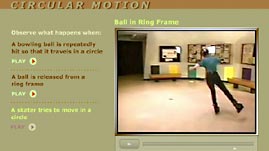Teachers' Domain - Digital Media for the Classroom and Professional Development
User: Preview

Source: Rutgers Physics and Astronomy Education Research Group
In this interactive activity featuring videos adapted from the Rutgers PAER Group, learn about how centripetal force acts on an object to keep it moving in a circular path. In the first video, a man hits a moving ball with a stick so that it travels in a circle. In the next video, a ball is set into motion inside a metal ring on a flat surface; the ball travels a circular path inside the ring until a section of the ring is removed. In the last video, a woman on rollerblades skates in a circle while holding onto a rope anchored by a man at the center of the circle; she also skates in a circle by herself by pushing off with her outside foot.
A force (a push or a pull) is a vector quantity, which means it has both magnitude and direction. When more than one force acts on an object, the force vectors are added together to determine the resultant, or net, force. The motion of an object changes only when a non-zero net force is applied.
Forces may be balanced, as in the case of a book sitting on a table. The force of gravity pulling the book down is equal to the force of the table pushing the book up, so the forces are balanced and the net force is zero. As a result, the book sits motionless on the table. According to Newton's first law of motion, in the absence of a net force, an object at rest will remain at rest. Similarly, if there is zero net force acting on an object in motion, it will continue moving at a constant speed and in a straight line.
However, unbalanced forces—forces that result in a non-zero net force—will cause a change in the velocity of an object. In physics, the vector quantity "velocity" describes speed with direction. If the velocity of an object changes over time, that means the object experiences acceleration. In other words, a net force causes acceleration. While "acceleration" is commonly assumed to mean an increase in speed, in physics, acceleration is a vector quantity that refers to the rate of change of velocity. An accelerating object could be slowing down or even maintaining a speed and changing direction only.
When an object moves in a circular motion, its velocity is constantly changing. Even if the object maintains a constant speed, its velocity changes because its direction of motion continuously changes. To experience a change in velocity, the object must experience acceleration from an outside force. The force that causes an object to follow a circular path is known as centripetal force.
Centripetal force acts perpendicular to the motion of the object and is always directed inward toward the center of the circle. If a force acts at a right angle to the motion of the object, the speed of the object will not change, but its direction will. It is this push toward the center that continuously changes an object's direction of motion and keeps it moving along a curved path. For example, if you tie a ball to a string and spin it horizontally over your head by holding the other end of the string, the tension in the string provides the centripetal force. If you let go of the string, the ball will no longer move in a circle—it will continue moving in the direction it was moving when you released the string.
 Loading Standards
Loading Standards Teachers' Domain is proud to be a Pathways portal to the National Science Digital Library.
Teachers' Domain is proud to be a Pathways portal to the National Science Digital Library.
